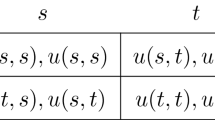Abstract
A cooperative game in characteristic-function form is obtained by allowing a number of individuals to esercise partial control over the constraints of a (generally nonlinear) mathematical programming problem, either directly or through committee voting. Conditions are imposed on the functions defining the programming problem and the control system which suffice to make the game totally balanced. This assures a nonempty core and hence a stable allocation of the full value of the programming problem among the controlling palyers. In the linear case the core is closely related to the solutions of the dual problem. Applications are made to a variety of economic models, including the transferable utility trading economies of Shapley and Shubik and a multishipper one-commodity transshipment model with convex cost functions and concave revenue functions. Dropping the assumption of transferable utility leads to a class of controlled multiobjective or ‘Pareto programming’ problems, which again yield totally balanced games.
Similar content being viewed by others
References
L.J. Billera, “On games without side payments arising from a general class of markets”,Journal of Mathematical Economics 1 (1974) 129–139.
L.J. Billera and J. Raanan, “Cores of non-atomic linear production games”,Mathematics of Operations Research 6 (1981) 420–423.
O.N. Bondareva, “Some applications of linear programming methods to the theory of cooperative games” (in Russian),Problemy Kibernetiki 10 (1963) 119–139.
V.P. Crawford and E.M. Knoer, “Job matching with heterogeneous firms and workers”,Econometrica 49 (1981) 437–450.
P. Dubey and L.S. Shapley,Totally balanced games arising from convex programs, Report No. 15/80, Institute for Advanced Studies, The Hebrew University of Jerusalem (May 1980).
S. Hart, “On the number of commodities required to represent a market game”,Journal of Economic Theory 27 (1982) 163–169.
T. Ichiishi, “Coalition structures in a labor managed market economy”,Econometrica 45 (1977) 341–360.
E. Kalai and E. Zemel, “Totally balanced games and games of flow”,Mathematics of Operations Research 30 (1982) 476–478.
E. Kalai and E. Zemel, “Generalized network problems yielding totally balanced games”,Operations Research 30 (1982) 998–1008.
M. Kaneko, “The central assignment game and the assignment markets”,Journal of Mathematical Economics 10 (1982) 205–232.
G. Owen, “On the core of linear production games”,Mathematical Programming 9 (1975) 358–370.
J. Rosenmüller, “LP games with sufficiently many players”,International Journal of Game Theory 11 (1982) 124–149.
D. Samet and E. Zemel, “On the core and dual set of linear programming games”,Mathematics of Operations Research, to appear.
H. Scarf, “The core of ann person game”,Econometrica 35 (1967) 50–69.
L.S. Shapley, “Simple games: An outline of the descriptive theory”,Behavioral Science 7 (1962) 59–66.
L.S. Shapley, “On balanced sets and cores”,Naval Research Logistics Quarterly 14 (1967) 453–460.
L.S. Shapley, “On balanced games without side payments”, in: T.C. Hu and S.M. Robinson, eds.,Mathematical programming, Academic Press, New York, 1973; 261–290.
L.S. Shapley and M. Shubik, “On market games”,Journal of Economic Theory 1 (1969) 9–25.
L.S. Shapley and M. Shubik, “The assignment game I: The core”,International Journal of Game Theory 1 (1972) 111–130. (Also see L.S. Shapley, Markets as cooperative games, Paper P-629, The Rand Corporation, Santa Monica, March 1955).
L.S. Shapley and M. Shubik, “Competitive outcomes in the cores of market games”,International Journal of Game Theory 4 (1975) 229–237.
D. Sondermann, “Economies of scale and equilibria in coalitional production economies”,Journal of Economic Theory 8 (1974) 259–291.
G.L. Thompson: “Computing the core of a market game”, in: A. V. Fiacco and K. O. Kortanek, eds.,Extremal Methods and Systems Analysis, Lecture Notes in Economic and Mathematical Systems No. 174 (Springer, Berlin, 1980) pp. 312–334.
Author information
Authors and Affiliations
Rights and permissions
About this article
Cite this article
Dubey, P., Shapley, L.S. Totally balanced games arising from controlled programming problems. Mathematical Programming 29, 245–267 (1984). https://doi.org/10.1007/BF02591996
Received:
Revised:
Issue Date:
DOI: https://doi.org/10.1007/BF02591996



